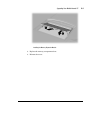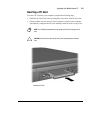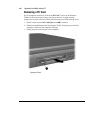
5
-4
Upgrading Your Mobile Internet PC
What Are PC Cards?
PC Cards (formerly known as PCMCIA Cards) are removable devices that increase
the storage or communications capability of your computer. PC Cards come in
three different sizes: Type I, Type II, and Type III. PC Cards have the following
things in common:
• 2 standard bus sizes, 16-bit (PCMCIA) or 32-bit (CardBus)
• 68-pin connectors
• approximately the same size as a credit card, but differences in thickness
PC Cards are easy to install. Other issues, however, especially software
considerations, can impact your ability to use them effectively.
The Personal Computer Memory Card International Association (PCMCIA) was
formed in 1989 to set industry standards for the use of PC Card technology.
PCMCIA represents more than 500 companies in the computer industry. As a
member of PCMCIA’s Board of Directors and Executive Committee, Compaq is a
driving force in the PC Card industry.
PC Card Types
PC Card types vary as follows:
• Type I cards are usually memory cards and are the thinnest at 3.3 mm.
• Type II cards, such as modem cards, are 5.0 mm thick.
• Type III cards, typically hard disk drives, are the thickest at 10.5 mm.
• Extended Type I, Type II, and Type III PC Cards are the same height and
width as standard size PC Cards. They have added length or thickness at one
end so they can accommodate external connectors or wireless PC Card
antennas.


















